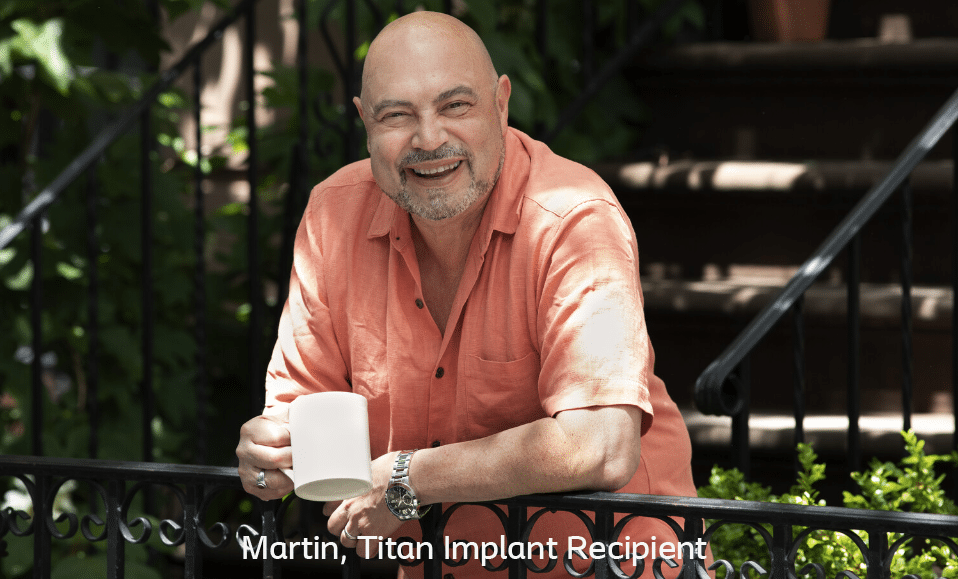No pills, no injections.
It’s all you.
The Titan® implant is a long-term ED solution that puts you back in control of your intimacy.
Take back control.
ED medications can fail many men3, yet still so many don’t know about the Titan penile implant as another option for their ED.
- Explore our reliable solution to a pervasive problem
- You can solve this
- Coloplast can help

Regain your intimacy.1
Don’t rely on a pill or shot – it’s time to let intimate moments happen freely again.
- No waiting for medication to kick in
- No wondering if you’ll be ready
- No more feelings of helplessness

of patients are satisfied with Titan® implant1

Most cost-effective ED treatment over 10 years3
Your struggle is real.
ED isn’t easy to talk about, let alone find a solution for. You’ve tried anything and everything. The Titan implant may be one thing you haven’t tried.
- You’re looking to regain confidence, be intimate, and improve your quality of life1
- You’re ready for a long-term solution to your ED4
- You’re not alone – up to 50% of men aged 40 to 70 experience some form of ED2

“It brought my confidence back. It opened up a new energy that I didn’t think I could have at this age.”
Tony
Titan Implant Recipient
Find a specialist near you
Choosing to take control over your ED is the first step in finding a solution. Starting the conversation with someone who can help is next. You need a specialist with the skills and experience you can trust.
Enter your zip code to see a listing of ED clinics and urology doctors in your area. Each listing provides the physicians in the country based on criteria such as the number of procedures performed, contributions to research in the field of erectile dysfunction, and leadership in professional associations for urologic physicians.
References
1 Data on file at Coloplast.
2 Sooriyamoorthy T, Leslie SW. Erectile Dysfunction. [Updated 2022 May 27]. In: StatPearls [Internet]. Treasure Island (FL): StatPearls Publishing; 2022 Jan-. Available from: https://www.ncbi.nlm.nih.gov/books/NBK562253/.
3 Moses RA, Anderson RE, Kim J. Keihani S, Craig JR, Myers JB, Lenherr SM, Brant WO, Hotaling JM. Erectile dysfunction management after failed phosphodiesterase-5-inhibitor trial: a cost-effectiveness analysis. Transl Androl Urol. 2019 Aug;8(4): 387-394.
4 Miller LE, Khera M, Bhattacharyya S, Patel M, Nitschelm K, Burnett AL. Long-Term Survival Rates of Inflatable Penile Prostheses: Systematic Review and Meta-Analysis. Urology. 2022 Aug;166:6-10.
PM-30059
Important safety information
Titan® & Titan Touch Inflatable Penile Prosthesis
The Titan Inflatable Penile Prosthesis is a surgically implanted mechanical penile implant intended for the treatment of erectile dysfunction in men. The Titan implant is a 3-piece fluid-filled system manually operated to produce and sustain an erection for sexual intercourse.
Indications
The Titan Inflatable Penile Prosthesis is indicated for male patients with erectile dysfunction who are considered to be candidates for implantation of a penile prosthesis.
Contraindications
The Titan implant is not for use in patients who have one or more of the following conditions: 1) have an active infection, particularly urinary tract or genital infection, 2) are sensitive or allergic to silicone or polyurethane, 3) have ongoing difficulty urinating or emptying the bladder (e.g., bladder outlet obstruction or neurogenic bladder), or 4) unwilling to undergo any further surgery for device revision.
Warnings
Patients should consider the warnings, precautions and potential complications associated with the use of this product, which may include the following: potential for resurgery (note: device is not a lifetime implant). Implantation makes latent natural erections, as well as other interventional treatment options, impossible. Implantation may result in penile shortening, curvature or scarring. Pre-existing abdominal or penile scarring or contracture may make surgical implantation more complicated or impractical. Diabetic, as well as immunocompromised patients, may have an increased risk of infection which could result in permanent damage to tissue/organs. Excessive stresses from rigorous exercise and vigorous masturbation/intercourse could lead to device damage. Certain stresses and pressures (straddle seating, obesity, etc.) could lead to involuntary inflation or deflation. Post-implant penile size, girth and angle can vary based on patient anatomy, implant size, level of inflation, and presence of Peyronie’s disease.
Precautions
Patients with spinal cord injury may have an increased risk of infection. This device may be used to treat erectile dysfunction in the presence of Peyronie’s disease. Although the implant is not visible, depending on the placement (submuscular) the reservoir may be palpable.
Patients should consider the following factors which could lead to increased risk of failure and can be critical to the eventual success of the procedure: ability and willingness of the patient to follow instructions; associated psychological status (e.g., psychogenic erectile dysfunction, inappropriate attitude or motivation); health conditions which hamper sexual activity (such as severe angina) may prevent successful use of this device; manual dexterity problems; and lack sufficient manual dexterity or strength necessary to operate the device.
Impact injuries to the pelvic or abdominal areas (e.g., sports injuries) can result in damage to the implant which may necessitate replacement of the device. Contracture of tissue around the pump can cause unnatural firmness in the scrotum and involuntary inflation or deflation. The device may fail to deflate and/or deflation of the device may be slow or difficult for some patients. Device malfunctions may result in the inability to inflate or deflate the device. Removal of the device without timely reimplantation of a new implant may complicate subsequent reimplantation.
Potential Complications
Adverse events are known to occur with penile protheses procedures and implants; some may require revision surgery or removal of the implant. Adverse events following penile protheses implantation may be new onset (de novo), persistent, worsening, transient, or permanent.
Adverse events may include but are not limited to: inability to pull foreskin back from tip of uncircumcised penis (acquired phimosis); abnormal wound healing/adhesion/scar tissue; bladder storage symptoms/urinary retention; tightening, shortening, deformity or curvature of penis (capsular contracture, induration); discomfort/pain; injury to tissue or organs (perforation/erosion/extrusion) resulting in damage or loss of tissue (necrosis); open tunnel between tissue or organs (fistula); foreign body reaction/allergic reaction/sensitivity; bleeding/hemorrhage or collection of blood or fluid outside of tissue or vessels (hematoma/seroma); hernia; Infection/urinary tract infection; redness or swelling (inflammation/edema); difficult or painful intercourse (dyspareunia/sexual dysfunction); obstruction/occlusion; numbness or decreased sensation (e.g., hypoesthesia); and urinary incontinence. The occurrence of these events may require one or more subsequent surgeries which may or may not always fully correct the complication.
This treatment is prescribed by your physician. Discuss the treatment options with your physician to understand the risks and benefits of the various options to determine if an inflatable penile implant is right for you.
Caution: Federal law (USA) restricts this device to sale by or on the order of a physician.
PM-15451 / Feb 2024




